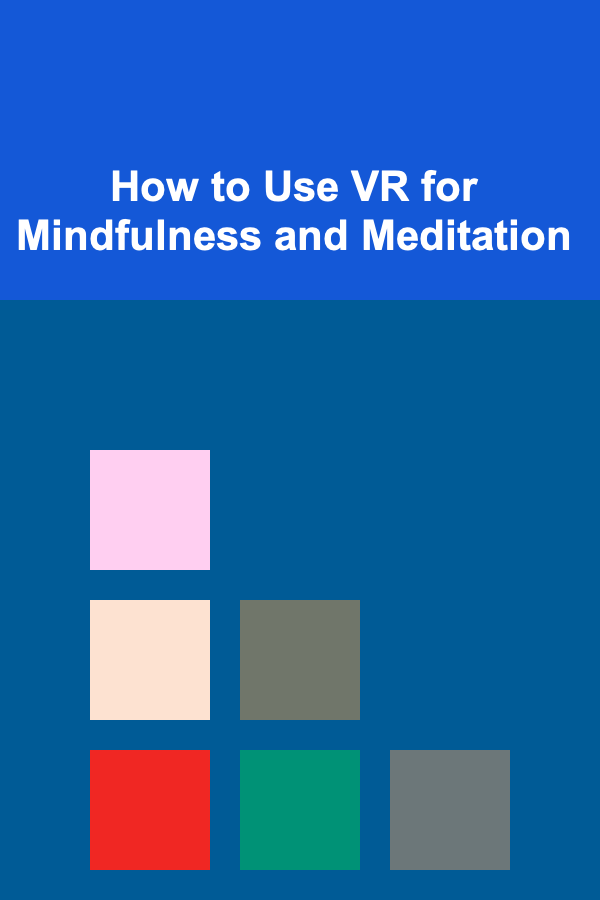
How to Use VR for Mindfulness and Meditation
ebook include PDF & Audio bundle (Micro Guide)
$12.99$6.99
Limited Time Offer! Order within the next:

In recent years, Virtual Reality (VR) has emerged as one of the most revolutionary technologies, making significant strides in areas ranging from gaming and education to healthcare and mental wellness. One of the most exciting applications of VR is its potential for enhancing mindfulness and meditation practices. By immersing users in calming, therapeutic environments, VR can transform how people approach mental health and self-care. This article explores how VR is being used for mindfulness and meditation, the benefits it offers, and how to effectively incorporate it into your daily practice.
What is Mindfulness and Meditation?
Before diving into how VR can be utilized for mindfulness and meditation, it's essential to understand what these terms mean in the context of mental well-being.
- Mindfulness is the practice of being present and fully engaged in the current moment. It involves paying attention to thoughts, feelings, and physical sensations without judgment. Mindfulness helps reduce stress, improve emotional regulation, and increase awareness.
- Meditation is a structured practice designed to foster mental clarity, emotional balance, and focus. While mindfulness is a form of meditation, meditation as a practice encompasses a variety of techniques aimed at calming the mind and promoting deep relaxation.
Both mindfulness and meditation have been shown to reduce anxiety, improve focus, and enhance overall emotional well-being. These practices often involve sitting quietly, focusing on breathwork, or following guided imagery. With the introduction of VR, these practices have gained a new dimension, making them more accessible and immersive than ever before.
The Role of VR in Mindfulness and Meditation
Virtual Reality offers a unique way to deepen mindfulness and meditation practices by creating immersive environments that encourage relaxation and focus. Here's how VR enhances mindfulness and meditation:
1. Immersive Environments
One of the most significant advantages of VR is its ability to transport users to different environments. Traditional mindfulness practices often involve closing the eyes or focusing on a particular point in the room. With VR, users can be fully immersed in a calming virtual world---whether that's a peaceful beach, a quiet forest, or a serene mountaintop. These virtual environments can provide immediate relief from the stresses of daily life, helping individuals to disconnect from distractions and focus entirely on their practice.
2. Personalized Guided Meditation
Many VR platforms offer personalized guided meditation sessions that cater to various needs. These sessions are designed to help users relax, focus, and reduce anxiety. For example, VR meditation apps often provide guided breathing exercises, visualizations, or even progressive muscle relaxation. The VR platform can track the user's progress and offer tailored recommendations to suit their emotional state or stress levels. This can be especially beneficial for beginners who may find it difficult to meditate on their own.
3. Emotional Regulation Through VR
One of the most powerful applications of VR in mindfulness is its ability to help individuals regulate their emotions. VR-based mindfulness exercises can be used to help users manage stress, anxiety, and other difficult emotions. Virtual environments can guide users through calming exercises while simultaneously helping them process emotions in a safe, controlled space. For instance, individuals suffering from anxiety or panic attacks may benefit from VR programs designed to create a sense of calm and safety, allowing them to better manage overwhelming feelings.
4. Reducing Cognitive Load
Mindfulness practices typically require individuals to clear their minds and focus their attention. However, in a busy world full of distractions, achieving this state of mental clarity can be difficult. VR offers a solution by blocking out external stimuli and providing users with an environment where they can focus solely on their practice. By eliminating external distractions, VR can help reduce cognitive load, making it easier for users to engage in mindfulness or meditation.
Benefits of Using VR for Mindfulness and Meditation
The benefits of VR-based mindfulness and meditation are vast and diverse. Below are some of the most notable advantages:
1. Enhanced Focus and Concentration
By immersing the user in a calming, distraction-free environment, VR enhances focus and concentration during meditation sessions. Without the typical distractions of a real-world environment, individuals can concentrate more effectively on their breathing, body sensations, or guided instructions. This level of focus can lead to a deeper meditative experience, helping users achieve a greater sense of calm and clarity.
2. Accessibility for Beginners
For many people, especially beginners, meditation can be a challenging practice to start. Traditional meditation requires discipline and a quiet space, which may not always be available. VR removes these barriers by providing users with a virtual space that is conducive to meditation. Guided sessions can also help beginners learn the basics of mindfulness and meditation, offering them support throughout the process. The ability to practice in a controlled, immersive environment can significantly reduce the anxiety or frustration that beginners may feel.
3. Convenience and Flexibility
One of the main advantages of VR meditation is its convenience. With VR, users can access mindfulness and meditation practices at any time and from anywhere. Whether at home, at work, or on the go, users can quickly transport themselves to a virtual space that promotes relaxation. The flexibility of VR also allows users to choose the duration of their sessions, allowing for meditation practices as short as five minutes or as long as an hour, depending on the user's schedule.
4. Stress Reduction
A major benefit of both mindfulness and meditation is their ability to reduce stress, and VR significantly enhances this effect. VR environments have been shown to lower cortisol levels (a hormone associated with stress), reduce heart rate, and promote feelings of relaxation. The immersive experience of VR, combined with calming visuals and sounds, creates a powerful tool for stress management, enabling users to unwind after a long day or calm themselves in moments of anxiety.
5. Improved Mental Health
Consistent use of VR for mindfulness and meditation can lead to long-term improvements in mental health. Studies have shown that mindfulness practices can reduce symptoms of depression, anxiety, and PTSD. When combined with VR technology, these benefits are amplified. Virtual reality can provide a more engaging, enjoyable, and effective way for individuals to practice mental health techniques that foster emotional resilience and overall well-being.
How to Use VR for Mindfulness and Meditation
Now that we understand the potential of VR for mindfulness and meditation, let's explore how you can use this technology effectively.
1. Choose the Right VR Meditation App
The first step in incorporating VR into your mindfulness or meditation practice is selecting the right app. There are numerous VR platforms available that offer guided meditation sessions, relaxation exercises, and mindfulness training. Some popular VR meditation apps include:
- TRIPP -- This app provides a variety of immersive meditation experiences, combining guided sessions with calming visuals and sounds to create an engaging mindfulness experience.
- Relax VR -- Aimed at reducing stress and promoting relaxation, Relax VR offers tranquil virtual environments such as beaches, forests, and mountains, allowing users to meditate in beautiful, serene settings.
- Calm -- Known for its mindfulness and relaxation techniques, Calm now offers VR-based experiences that enhance meditation practices with soothing visuals and calming audio.
- Breethe -- Breethe's VR platform offers guided meditation sessions for various purposes, including stress reduction, sleep improvement, and relaxation.
2. Create a Comfortable Space
While VR can immerse you in calming environments, it's essential to create a comfortable and quiet physical space where you can practice. Ensure that your room is free of distractions, and adjust your headset for maximum comfort. If possible, use a comfortable chair or mat to sit on during your session. This will help enhance your overall experience and allow you to fully engage with the virtual environment.
3. Start with Short Sessions
If you're new to VR meditation, it's a good idea to start with shorter sessions---5 to 10 minutes---to avoid feeling overwhelmed. As you become more comfortable with the technology, you can gradually increase the length of your sessions. Take your time to adjust to the virtual environment, and don't rush through the process. The goal is to find a rhythm that works for you.
4. Focus on Your Breathing
Regardless of the virtual environment you choose, always focus on your breath during your meditation practice. Many VR meditation apps will guide you through breathing exercises, but you can also focus on your natural breath. Slow, deep breaths can help activate the parasympathetic nervous system, which is responsible for the body's relaxation response.
5. Reflect After Your Session
Once you've finished your VR meditation session, take a few moments to reflect on your experience. How do you feel? Have you noticed any changes in your mood, stress levels, or mental clarity? Journaling your thoughts or engaging in light reflection can help deepen the effects of your practice and guide your future sessions.
Potential Challenges and Considerations
While VR-based mindfulness and meditation offer many benefits, there are some challenges and considerations to keep in mind:
1. Motion Sickness
Some users may experience motion sickness or discomfort while using VR. If you are prone to motion sickness, start with shorter sessions and gradually increase the duration as your body becomes accustomed to the virtual world. You can also try adjusting the settings on your VR headset to reduce motion blur and improve comfort.
2. Over-Reliance on Technology
While VR is a powerful tool, it's essential to remember that mindfulness and meditation can be practiced without technology. Be mindful of not becoming overly reliant on VR for your practice. Balance virtual meditation with traditional methods, such as sitting in silence or practicing mindful walking, to maintain a well-rounded practice.
3. Equipment Costs
VR technology can be expensive, and not everyone may have access to high-quality VR equipment. However, there are a variety of VR platforms and headsets at different price points, so it's important to research and find one that fits your budget.
Conclusion
Virtual Reality offers a transformative way to engage in mindfulness and meditation, making these practices more accessible, immersive, and effective. By providing distraction-free environments, personalized guidance, and convenient access to meditation sessions, VR enhances traditional mindfulness practices and helps individuals improve their mental well-being. As the technology continues to evolve, VR has the potential to revolutionize how we approach mindfulness and meditation, offering new avenues for self-care, stress relief, and emotional regulation. Whether you're a beginner or an experienced practitioner, VR can be an invaluable tool in your journey towards mental clarity and relaxation.

How to Have a Family Dance-Off and Get Active Together
Read More
How to Manage Time Wisely During Busy Seasonal Periods
Read More
How to Plan a Family DIY Home Project
Read More
How to Plan an Eco-Friendly Home Party with Sustainability in Mind
Read More
How to Use Technology to Enhance Your Home Staging Process
Read More
How To Leverage Your Volunteer Experience on Your Resume
Read MoreOther Products

How to Have a Family Dance-Off and Get Active Together
Read More
How to Manage Time Wisely During Busy Seasonal Periods
Read More
How to Plan a Family DIY Home Project
Read More
How to Plan an Eco-Friendly Home Party with Sustainability in Mind
Read More
How to Use Technology to Enhance Your Home Staging Process
Read More